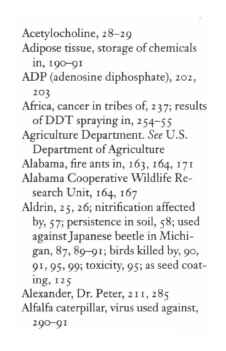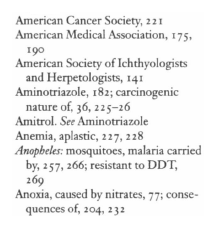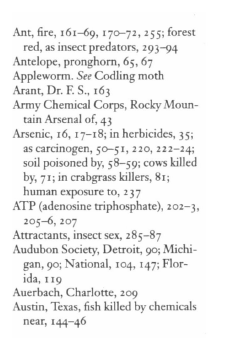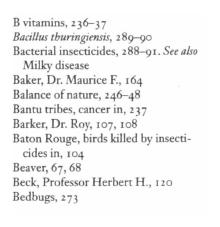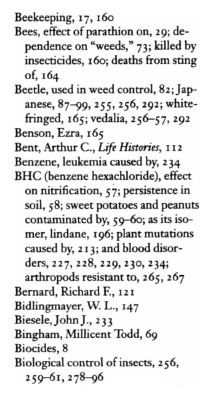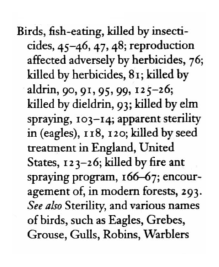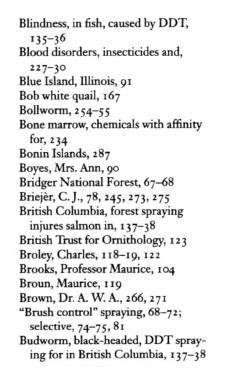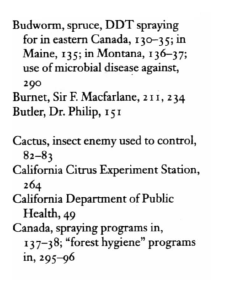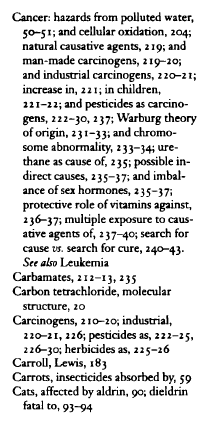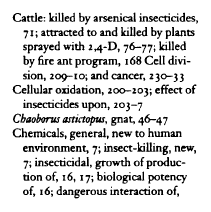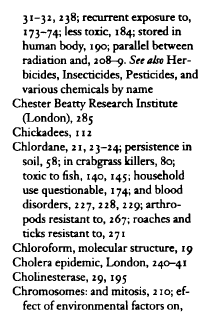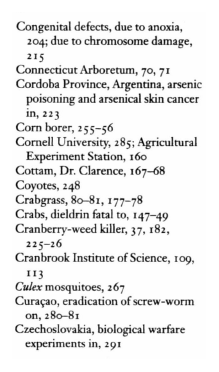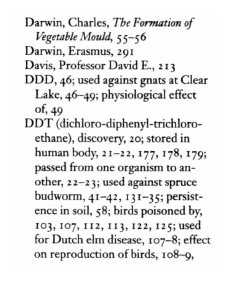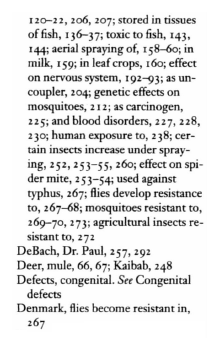Silent Spring (48 page)
Authors: Rachel Carson

A collateral effect of
Silent Spring
was the boost it gave to conservation of natural environments. Chemical pollution is the third-ranking cause of species extinction in the United States, after habitat destruction and "biological pollution"âthe influx of alien species that outcompete and push back native ones. The general environmental concern abetted by
Silent Spring
resulted
in the passage in 1973 of the Endangered Species Act by a near-unanimous vote in Congress. In concept and effect the act is easily the most important piece of conservation legislation in the nation's history. Its most dramatic successes include the recovery of the American alligator, gray whale, bald eagle, peregrine falcon, and eastern population of the brown pelican. All were imperiled forty years ago, and all are now considered relatively safe.
The environmental movement nevertheless is still forced to work its way up the rough side of the mountain, even in the country that gave it birth. If Rachel Carson were alive today, I believe she would give America a mixed grade. The increased public awareness of the environment would please the educator in her; the ranking of her book as a literary classic would astonish the writer; and the existence of new regulatory laws would gratify the frustrated government bureaucrat. The naturalist in Rachel Carson, positioned at the core of her several parts, would take pleasure in knowing that ecocidal schemes such as the sea-level canal and the fire ant eradication program, if broached today, would be widely ridiculed and perish stillborn.
Even so, she would recognize that the war between environmentalists and exploiters, local and national, is far from over. It has only subsided since 1962 to a more muted equilibrium. Although developers and policymakers come up with fewer spectacularly bad large projects, they continue to chip, saw, and drill away at the remains of the American natural environment. They say, over and over, we just need a little more here and there. The environmentalists respond by saying, pull back: nature is dying the torture-death of a thousand cuts.
Of the 1,254 species protected under the Endangered Species Act at the end of 1991, four times as many are declining as are gaining in population. The enemies of federal environmental regulation cite this difference as evidence that the act has failed. Their logic, if applied widely, would call for closing hospital emergency rooms because so many people die there. They declare the Endangered Species Act a detriment to economic
growth, conveniently ignoring the fact that fewer than one in a thousand projects reviewed under its provisions has been halted.
During the past forty years the United States has come to understand that it is a major player in the deterioration of the global environment. Rachel Carson, who was a quick learner, would be ahead of us in understanding the devastating effects everywhere of still-rocketing population growth combined with consumption of natural resources, the thinning of the ozone layer, global warming, the collapse of marine fisheries, and, less directly through foreign trade, the decimation of tropical forests and mass extinction of species. She would regret, I am sure, the sorry example the United States sets with its enormous per capita appropriation of productive land around the world for its consumptionâten times that of developing countries.
On the other hand, the lady from Maryland would take some hope from Earth Summit, the successful Montreal Protocol aimed at the reduction of ozone-thinning chlorofluorocarbons, and the less successful Kyoto Protocol designed to slow climatic warming (still thwarted in 2002 by lack of American approval). She would be cheered by news of the rapid growth in funding by the muscle of such global nongovernmental organizations as Conservation International, the Nature Conservancy, and the World Wildlife FundâU.S.
Silent Spring
continues to be worthy of our attention because it marks an important moment in history, just as Harriet Beecher Stowe's
Uncle Tom's Cabin
and John Muir's
Our National Parks do.
The examples and arguments it contains are timeless lessons of the land we need to reexamine. They are also timely, because the battle Rachel Carson helped to lead on behalf of the environment is far from won.
We are still poisoning the air and water and eroding the biosphere, albeit less so than if Rachel Carson had not written. Today we understand better than ever why we must press the effort to save the environment all the way home, true to the mind and spirit of the valiant author of
Silent Spring.
